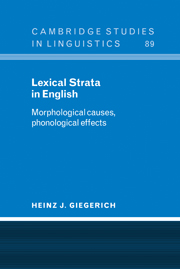Book contents
- Frontmatter
- Contents
- Acknowledgements
- 1 A requiem for Lexical Phonology?
- 2 Affix-driven stratification: the grand illusion
- 3 Principles of base-driven stratification
- 4 Derving the Strict Cyclicity Effect
- 5 Phonology and the literate speaker: orthography in Lexical Phonology
- 6 [r]-sandhi and liaison in RP
- 7 Input vowles to [r]-sandhi: RP and London English
- 8 Syllables and strata
- Notes
- References
- Subject index
- Index of words, roots and affixes
2 - Affix-driven stratification: the grand illusion
Published online by Cambridge University Press: 22 September 2009
- Frontmatter
- Contents
- Acknowledgements
- 1 A requiem for Lexical Phonology?
- 2 Affix-driven stratification: the grand illusion
- 3 Principles of base-driven stratification
- 4 Derving the Strict Cyclicity Effect
- 5 Phonology and the literate speaker: orthography in Lexical Phonology
- 6 [r]-sandhi and liaison in RP
- 7 Input vowles to [r]-sandhi: RP and London English
- 8 Syllables and strata
- Notes
- References
- Subject index
- Index of words, roots and affixes
Summary
The origins
Let us assume that the English lexicon is divided into two strata. This is not only the position that appears to have met with broad consensus in recent research; it will also be extensively argued for in later chapters. Moreover, it happens to be the position most closely associated with Siegel's (1974) original observations and claims, which were to prove seminal to the framework while in turn harking back at least to SPE. Such origins are worth investigating, especially when – as we shall see – they are also the origins of a major flaw in most current stratification models.
At the root of the two-strata model lies the familiar generalisation, dating back to SPE and beyond (for example Bloomfield 1933), and related to the more general ‘close-juncture’ vs. ‘open-juncture’ distinction found in the American structuralist tradition (for example Trager and Smith 1951), that the derivational morphology of English has two types of affixation processes, distinguished from each other empirically by a syndrome of differences in terms of morphological and phonological behaviour that will be discussed in some detail below. The well-known ‘stress-shifting’ vs. 'stress-neutral’ effect on the affixation base is one such difference in behaviour. In formal terms, SPE expresses the distinction by associating affixes with different boundary symbols, ‘#’ and ‘+’, where the former ‘word boundary’ serves, among other things, to block the cyclic application of stress rules – #-affixes therefore lie outwith the domain of the stress rules, their presence having no effect on the stress pattern of the base – while the latter ‘morpheme boundary’ does not block the cyclic (re-)application of stress rules. Witness the stress shifts caused by the addition of +-affixes in átom – atóm+ic – àtom+íc+ity, and the absence of such shifts in átom – átom#less – átom#less#ness.
- Type
- Chapter
- Information
- Lexical Strata in EnglishMorphological Causes, Phonological Effects, pp. 7 - 52Publisher: Cambridge University PressPrint publication year: 1999



